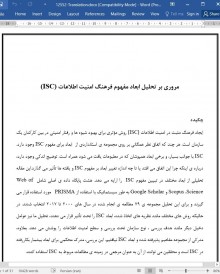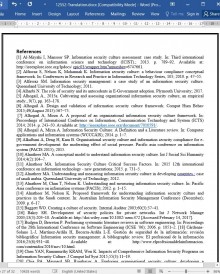
دانلود مقاله مروری بر تحلیل ابعاد مفهوم فرهنگ امنیت اطلاعات (ISC)
چکیده
ایجاد فرهنگ مثبت در امنیت اطلاعات (ISC) روش مؤثری برای بهبود شیوه ها و رفتار امنیتی در بین کارکنان یک سازمان است. هر چند که اتفاق نظر همگانی بر روی مجموعه ی استانداردی از ابعاد برای مفهوم ISC وجود دارد. ISC با جوانب بسیار، و برخی ابعاد همپوشان که در مطبوعات یافت می شود همراه است. توضیح اندکی وجود دارد، درباره ی اینکه چرا این اتفاق می افتد یا تا چه اندازه تغییر ابعاد بر مفهوم ISC و یافته ها تأثیر می گذارد.این مقاله تحلیلی از ابعاد مختلف در تبیین مفهوم ISC را ارایه می دهد. هشت پایگاه داده ی اصلی شامل Web of Science، Scopus و Google Scholar به طور سیستماتیک با استفاده از PRISMA مورد استفاده قرار می گیرند و برای این تحلیل مجموعه ی 79 مطالعه ی انجام شده در سال های 2000 تا 2017 انتخاب شدند. در حالیکه روش های مختلف مانند نظریه های اتخاذ شده، ابعاد ISC را تحت تأثیر قرار می دهند، تحلیل ما نیز عوامل دخیل دیگر مانند هدف بررسی ، نوع سازمان تحت بررسی و سطح امنیت اطلاعات را پوشش می دهد. بعلاوه، مدرکی از مجموعه مفاهیم پذیرفته شده و ابعاد ISC نیافتیم. این بررسی، مدرک محکمی برای ابعاد بیشمار بکاررفته در ISC است و محققین می توانند از آن به عنوان مرجعی در زمینه ی مطالعات مربوط به ISC استفاده کنند.
1. مقدمه
فرهنگ امنیت اطلاعات (ISC)به عنوان روشی مؤثر برای ارتقای رفتار امنیتی و مدیریت خطاهای امنیتی در سازمان پذیرفته می شود ( Baggett [15]، Dervin, Kruger and Stey[27]، Martins and Eloff[63]، Ruighaver and Maynard [95]، Schlienger and Teufel [103]، Von Solms[123]، Zakaria [126]). اگرچه مطالعات زیادی در این حوزه وجود دارد، اما با وجود استفاده از زوایا و مفاهیم مختلف، ابعاد قابل قبول برای ISC کم است. این موضوع، مشکلاتی را برای محقق در تشخیص مفهوم واقعی ISC و نیز برای کارمندان در تقویت و ارزیابی ISC مثبت در سازمان ، و بنابراین محدودیت توان کامل آن ایجاد می کند.
ابعاد مختلفی از ISC وجود دارد که در مطبوعات مربوط به رفتار تبعیت از سیاست امنیت اطلاعات (ISP) یافت می شود. برای مثال، D’Arcy و Greene [25] از تعهد بالای مدیریتی، ارتباطات امنیتی و مانیتورینگ کامپیوتری استفاده کردند در حالیکه Alkalbani ، Deng و Kam [9] از تعهد بالای مدیریتی، آگاهی از امنیت اطلاعات و توجیه پذیری بعنوان ابعاد ISC استفاده کردند. اگرچه آن ها از یک بعد مشترک (تعهد بالای مدیریتی) استفاده کردند، اما بر روی ابعاد دیگر اتفاق نظر نداشتند و در بررسی های خود از ابعاد متفاوتی استفاده کردند. اثر ISC نسبت به ISP نمی تواند به تنهایی به طور معناداری به ابعاد خاص نسبت داده شود.
6. نتیجه گیری و کارهای آینده
در این کار، مشخص شد که برای تولید مفهوم ISC از مفاهیم مختلفی به همراه فرهنگ سازمانی [97,99]که پرکاربردترین مفهوم بوده است، استفاده می شود. استفاده از رویکردها و مفاهیم مختلف باعث تغییراتی در ابعاد ISC می شود.ابعاد بسیار زیادی در مقالات وجود دارد که منجر به تعمیم و کاربرد مطالعات مربوط به ISC می شود. این بررسی ثابت کرد که تا زمانیکه هنوز توافق همگانی در مورد مفهوم ISC وجود ندارد ، توافق مشترکی در مورد جامع ترین ابعاد برای مفهوم ISC نیز وجود نخواهد داشت که محققین و کارورزان بتوانند به آن رجوع کنند. مفاهیم بکاررفته در یک بررسی فقط برای همان بررسی صحیح است و نمی توان آن را به همه ی ISC تعمیم داد. ما معتقدیم که در مطالعات آینده در زمینه ی ISC باید تلاش کرد تا این موضوع را برای فرمولبندی و اعتبارسنجی مفهوم ISC استاندارد مورد توجه قرار داد تا برای همه ی سازمان ها قابل استفاده باشد. از آنجاییکه هر سازمانی دارای سطح ISC متفاوتی است، مجموعه ی مشترکی از ابعاد انجام مقایسه ی عمده و جامع تری را میسر می سازد. این موضوع، برنامه ریزی و استراتژی های ISC بهتری را به دنبال خواهد داشت.
Abstract
The cultivation of positive Information Security Culture (ISC) is an effective way to promote security behavior and practices among employees in the organization. However, there is yet a consensus on a standard set of dimensions for the ISC concept. ISC has been associated with many facets, with some overlapping dimensions found in the literature. There is little explanation, if any, as to why this happens or to what extent do variances of dimensions affects ISC concept and findings. This paper presents an analysis of the different dimensions in conceptualizing the ISC. Eight major databases including Web of Science, Scopus and Google Scholar were systematically exhausted using PRISMA and a total of 79 studies from 2000 to 2017 was selected for analysis. While different approaches such as adopted theories affect the dimensions of ISC, our analysis also covered other contributing factors such as the objective of the study, type of organization under study and the information security maturity level. In addition, we found no evidence of a set of widely accepted concepts and dimensions for ISC. This review provides substantial evidence on the numerous dimensions used in ISC and could be utilized by academicians as a reference in ISC-related studies.
1. Introduction
Information Security Culture (ISC) is accepted as an effective way to promote secure behavior and to manage security risks in the organization (Baggett [15]; Dervin, Kruger and Steyn [27]; Martins and Eloff [63]; Ruighaver and Maynard [95]; Schlienger and Teufel [103]; Von Solms [123]; Zakaria [126]). Although there are numerous studies in this area, there is a lack of widely accepted dimensions for ISC as different perspectives and concepts are used. This causes problems for academician in identifying the actual concept of ISC as well as for the practitioners to cultivate and assess a positive ISC in the organization, thus limiting its full potential.
There are different dimensions of ISC found in the Information Security Policy (ISP) compliance behavior literature. For example, D’Arcy and Greene [25] used Top Management Commitment, Security Communications and Computer Monitoring whilst Alkalbani, Deng, and Kam [9] used Top Management Commitment, Accountability and Information Security Awareness as dimensions in ISC. Although they share a similar dimension (Top Management Commit- ment), they did not agree on other dimensions and incorporated different dimensions in their respective studies. As such, the effect of ISC towards ISP could not be significantly attributed to the specific dimensions.
6. Conclusion and future work
This work has revealed that various concepts are used to conceptualize ISC with organizational culture [97,99] being the most adopted concept. The use of different concepts and approaches led to the variances in ISC dimensions. There are numerous dimensions found in literature causing issues in the generalization and application of ISC-related studies. This study proved that while there is still no mutual agreement in conceptualizing the ISC, there is also no common agreement on the most comprehensive dimensions of ISC concept that could be referred by academician and practitioners. The concepts used in a particular study would hold true only to the study itself and could not be generalized to ISC as a whole. We firmly believe that future directions in ISC-related studies should attempt to address this issue for formulating and validating a standard ISC concept that is applicable to every organization. As each organization has a different level of ISC, a common set of dimensions would enable a more comprehensive and meaningful comparison to be made. This will lead to better ISC planning and strategies.
چکیده
1. مقدمه
2. روش
1-2 جستجو در مطبوعات
2-2 انتخاب موضوع بررسی و مقالات مناسب
2-3 استخراج داده ها و خلاصه
3. مفاهیم ISC مبتنی بر ابعاد
1-3 ISC مبتنی بر فرهنگ سازمانی
2-3 مدل ISC پیشنهادی Van Niekerk و Von Solms [77,78]
3-3 ISC مبتنی بر رفتار سازمانی
4-3 مدل ISC مبتنی بر چهارچوب فرهنگ امنیت اطلاعات (ISCF)
5-3 مدل های دیگر
6-3 گستره ی تغییرات در ابعاد ISC
4. بحث و مفاهیم
1-4. مفهوم عملی
5. محدودیت ها
6. نتیجه گیری و کارهای آینده
منابع
ABSTRACT
1. Introduction
2. Methodology
2.1. Literature search
2.2. Study selection and eligible papers
2.3. Data extraction and summary
3. ISC concepts based on dimensions
3.1. ISC based on organizational culture
3.2. ISC model by Van Niekerk and Von Solms [77,78]
3.3. ISC based on organizational behavior
3.4. ISC model based on information security culture framework (ISCF)
3.5. Other models
3.6. Extent of variances in ISC dimensions
4. Discussion and implication
4.1. Practical implication
5. Limitations
6. Conclusion and future work
References
- اصل مقاله انگلیسی با فرمت ورد (word) با قابلیت ویرایش
- ترجمه فارسی مقاله با فرمت ورد (word) با قابلیت ویرایش، بدون آرم سایت ای ترجمه
- ترجمه فارسی مقاله با فرمت pdf، بدون آرم سایت ای ترجمه



